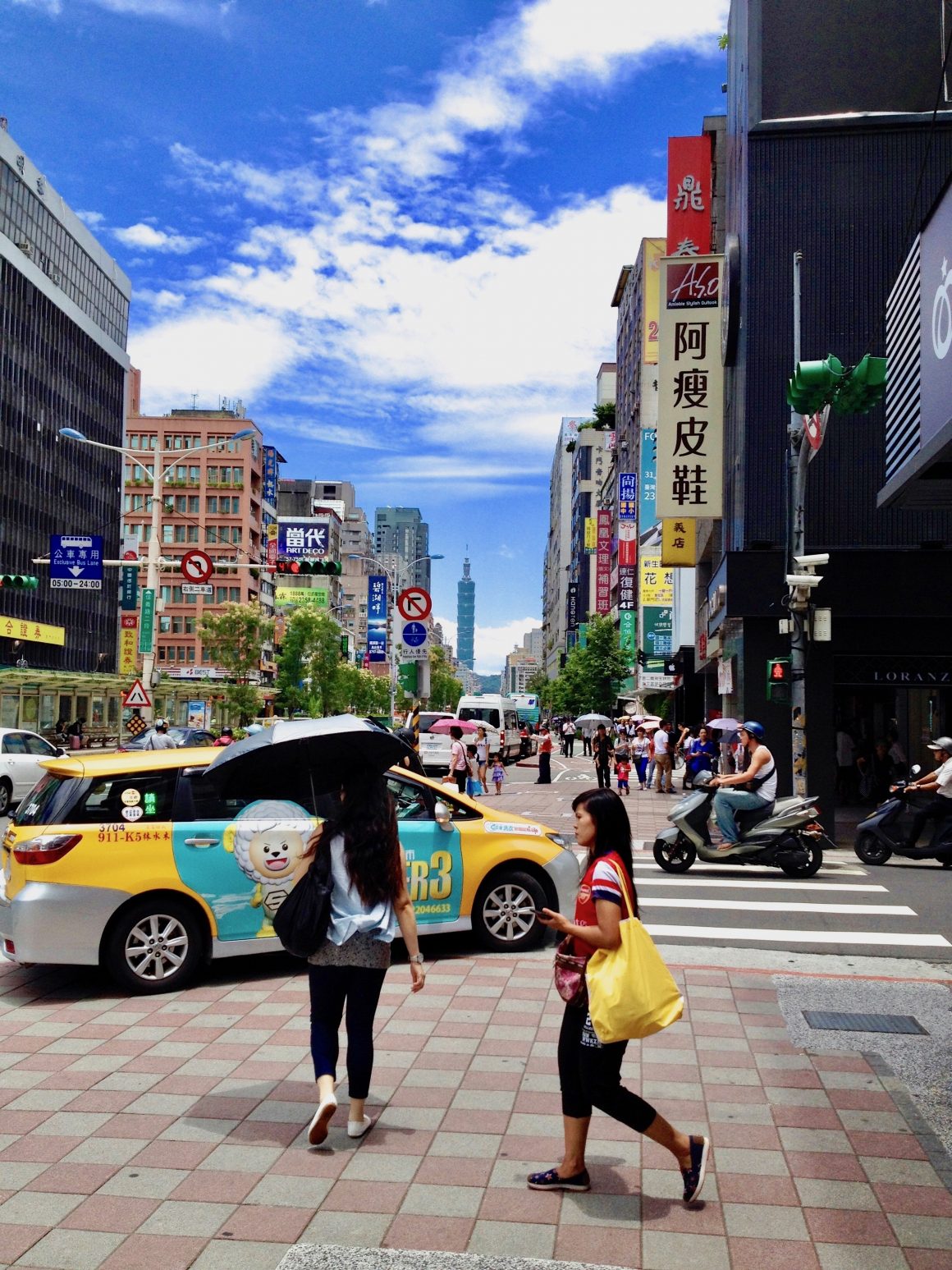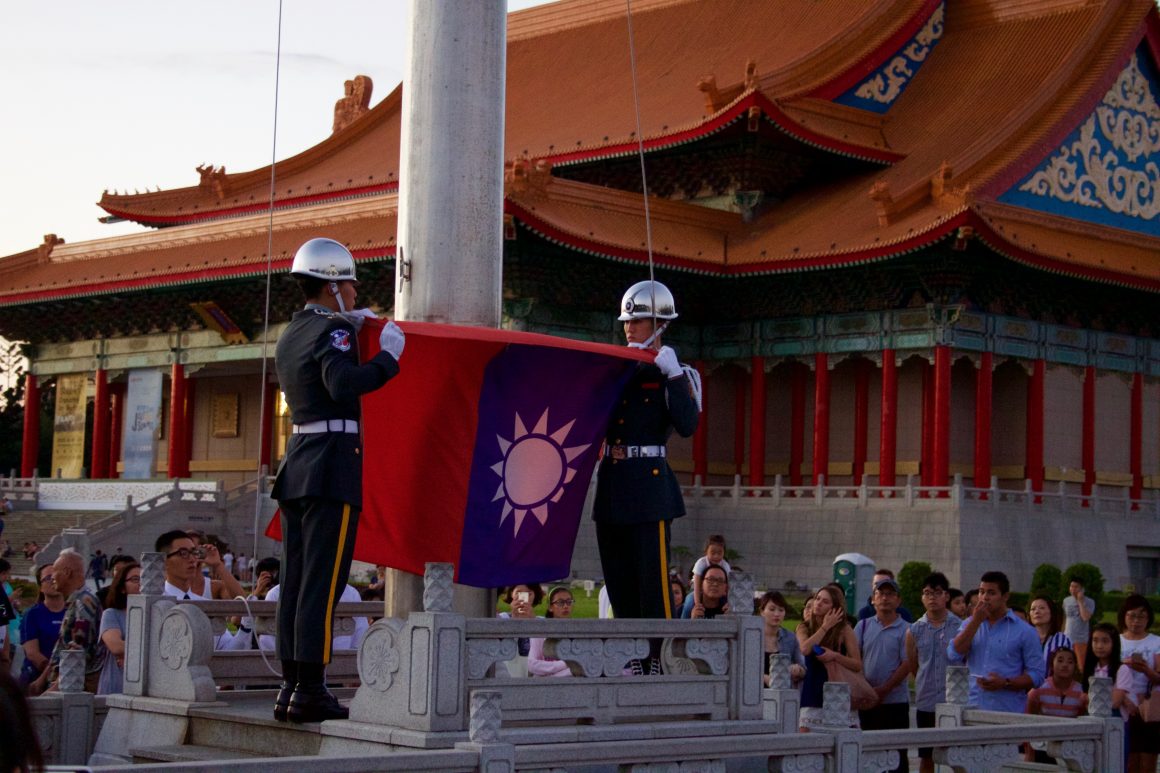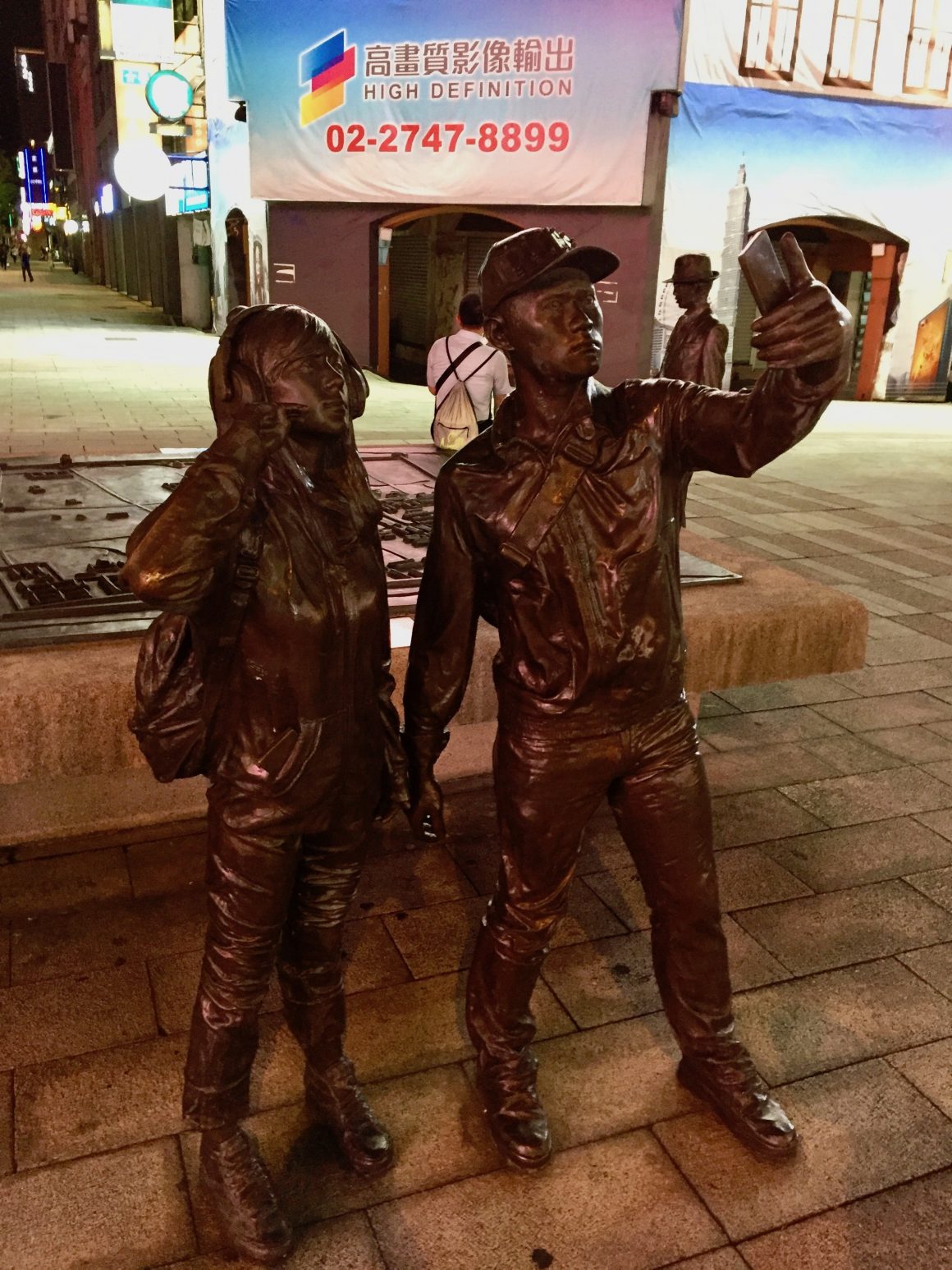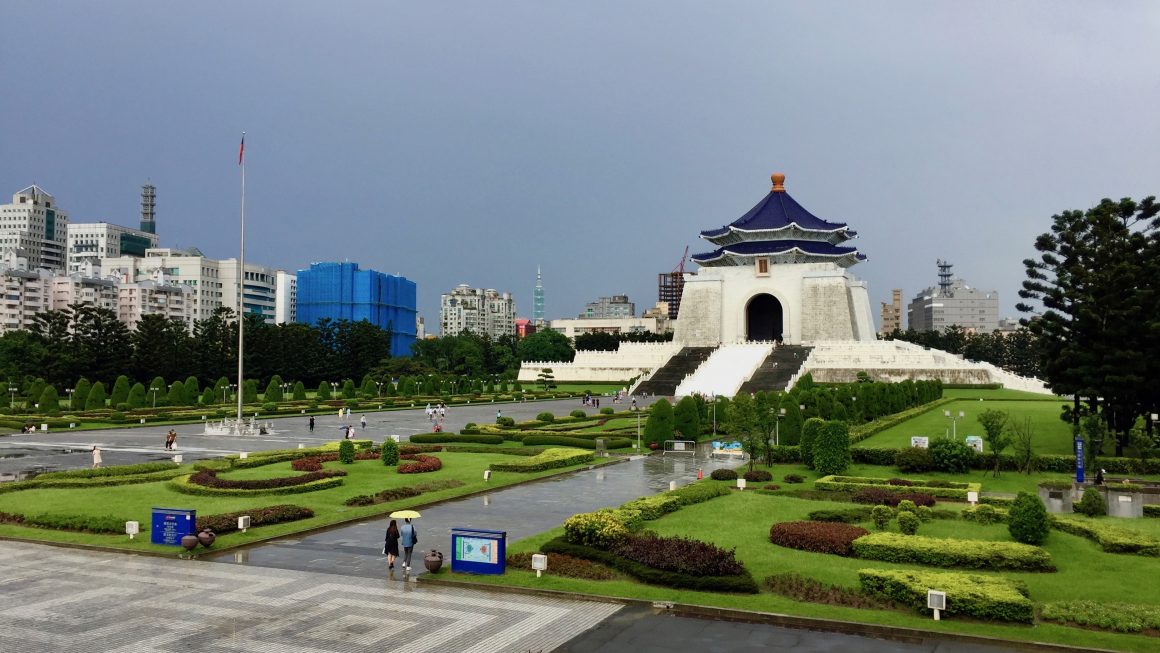THE WARSAW INSTITUTE REVIEW
Date: 6 July 2019 Author: PhD, Robert Rajczyk
Taiwan – the Only Chinese Democracy
The Republic of China, better known as Taiwan, maintains official diplomatic relations with only 17 countries in the world . Notwithstanding, it is an important player in the geopolitical conundrum of Southeast Asia and the global economy. At the same time, Formosa is an example of a successful socio-political and economic transformation.
 TAIWAN IS ONE OF THE MOST MODERN COUNTRIES IN THE WORLD. © PHOTO FROM THE AUTHOR’S PERSONAL COLLECTION
TAIWAN IS ONE OF THE MOST MODERN COUNTRIES IN THE WORLD. © PHOTO FROM THE AUTHOR’S PERSONAL COLLECTIONCertain notions and developments, critical to the regional and global geopolitical dynamics, are worth noticing and invite closer inspection. Inter alia, this includes that although Taiwan has the status of a non-recognized state, its currency – the new Taiwanese dollar is considered one of the most stable in the world. Furthermore, whilst Taiwanese democracy is only 30 years old, it is an example of a successful transformation – from martial law to political pluralism. Next, due to foreign investments and public aid, Taiwan has transformed from an agricultural country into a global leader in the production of electronics and semiconductors.
Taiwan became a subject of international interest in 1949. In that year, following the defeat in the civil war with Mao Zedong’s communist rebellion forces, the government of the Republic of China was evacuated to the island, where some of the most valuable exhibits from the Palace Museum in Beijing were transported earlier. Only once has Taiwan appeared on the agenda of world powers. In 1943 at a conference in Cairo, Winston Churchill and Franklin Delano Roosevelt agreed to give up Formosa (the name given to the island by the Portuguese explorers in the early 16th century) to the Republic of China. Taiwan was a Japanese province in the years 1895-1945 under the Treaty of Shimonoseki. Although having incited social resistance, Japanese rule was associated with the development of transport infrastructure, modernization of agriculture and electrification, as well as the introduction of universal education.
On March 1, 1950, the Republic of China was formally re-established in Taiwan with Chiang Kai-Shek escaping from the continent. Taiwan was a member of the United Nations until 1971 and held the status of Permanent Member of the Security Council as one of the founders of the United Nations. The USSR and its allies meanwhile considered Chinese representation to be the Chinese People’s Republic, which in fact controlled the continental part of China, while Taiwan was only the island of the same name along with the surrounding islands. Formally, however, Chiang Kai-Shek exercised dictatorial rule under martial law[1], and he regarded the Republic of China as the legitimate representation of all of China[2]. Meanwhile, as a result of the geopolitical rivalry of the world powers then, Taiwan ceased to be a member of the UN and all its agencies were replaced in lieu of the People’s Republic of China[3]. Taiwan is , therefore, a special case as an example of the withdrawalof international recognition.
Renown expert on international public law, Lech Antonowicz, claims that the Republic of China is only the successor of the Chinese state, not its continuing international legal entity, because “the identity and continuity of the constitutional law do not coincide with the identity and continuity of international law”[4].
In the light of international law, the Republic of China is thus an independent state, that is, it has only empiric statehood. The formal and legal status places Taiwan in a group of countries with disputed sovereignty, along with, inter alia, Kosovo, Western Sahara or Transnistria.
The political position of these entities’ sanctions not only the degree of international recognition, but above all the economic potential and geographic location[5]. The first of these factors generally determines the foreign policy of quasi-states. Taiwan again appears here as an exception due to the genesis of the uprising. It did not separate the borders of its territory from the home country, nor was it established as a result of the decision of an international organization. Unlike other unrecognized countries – for example, the Nagorno-Karabakh Republic or Transnistria – in the case of the Republic of China it is difficult to speak about the existence of a home state or a patron saint.
 AWARENESS OF A SEPARATE TAIWANESE IDENTITY IS GROWING SYSTEMATICALLY.© PHOTO FROM THE AUTHOR’S PERSONAL COLLECTION
AWARENESS OF A SEPARATE TAIWANESE IDENTITY IS GROWING SYSTEMATICALLY.© PHOTO FROM THE AUTHOR’S PERSONAL COLLECTIONGeopolitical Issue
The geographical location of Taiwan as guard somehow to the most important waterway in the South- East Asia does make the island a strategic object. The control over Formosa means strategic dominance in this region of the world in which one of the world’s major powers – China – plays the most important political and economic role. For this reason, but also because of the tradition of cooperation and the history of mutual relations, the US has on the basis of its relations with Formosa the possibility of exerting political influence on the People’s Republic of China. American support for Taiwan prevents Beijing from reuniting the island with the matrix, which is the political and ambition-driven goal of the Chinese communists as another element in the recovery of territories lost to foreign powers in the nineteenth century during the Opium Wars. Regarding Taiwan, the idea of regaining power over the continent has evolved into the concept of pragmatic independence, assuming the coexistence of two Chinese governments in recognizing each other as “political actors.” In Taiwan, the idea of exporting democracy to the continent has long since lost importance. The Chinese from the continent mostly appear as a society focused on the material dimension of their lives and improving its quality resulting from the incredible civilizational leap achieved on the continent through economic development.
Representatives of the local middle class, which formed as a result of economic reforms initiated by Deng Xiaoping, are aware to whom they owe their material status. The potential for possible mass mutiny is also mitigated by the Confucian concept of respect and obedience to authority. In turn, manifestations of social dissatisfaction are catalyzed by controlled criticism, which is also a tool for achieving political goals (exchange of party elites[6]) and the Social Trust System, the aim of which is to model an exemplary citizen through a system of point-based rewards, rewarding the fulfillment of civic obligations and the adaptation of the citizen to the desired social patterns. The Social Trust System is a Chinese response to the lack of social capital in the Middle Kingdom, but the goal of the program is not its social reconstruction, but rather social control. Democracy is , therefore, not a commodity of primary necessity for the Chinese who are increasingly living on a better standard of living than their ancestors. The Marxist idea of shaping consciousness has found its embodiment right now in the People’s Republic of China, effectively displacing the Western model of democracy from social consciousness. This is the case, among others, in Hong Kong – the former British colony – where the pro-democracy social protests of residents, mindful of their freedoms and guarantees of democratic freedoms from the time of British supremacy, are suppressed by force.
David vs. Goliath
The Taiwanese question finds a prominent place in Chinese politics. Since the communist rebellion of Mao Zedong, gaining control over Taiwan has become a matter of honor for the Chinese communists. They even added this to the preamble of the Constitution of the People’s Republic of China. After economic reforms of the People’s Republic of China made an authentic “big leap”in economic and civilizational terms, the matter of superiority over Taiwan gained even more significance, especially after the experience of taking over the colonial powers of Hong Kong and Macau. Chinese propaganda is intensively promoting the idea of ”one country, two systems”, offering this systemic solution as an opportunity to reintegrate Formosa with the continent. For the Chinese communists, taking control of the island in addition to the prestige dimension – national pride from the recovery of all areas occupied by foreign powers as a result of the nineteenth century Opium Wars – is primarily of strategic importance. The solution of the Taiwanese problem in Beijing’s mind would involve China’s military and political domination in this part of the world, and for the US it would mean problems in the implementation of defense commitments towards Japanese and South Korean allies[7].
Continental China believes that there is only “one China.”In this political conception, Taiwan is considered a mutinous province. To convince the international community to do so, they use political and economic means. The first of these factors entails effective opposition to even symbolic manifestation of Taiwanese separateness on the international arena, contributing to the deepening of the isolation of the Republic of China, as well as economic factors[8].
Taiwan, however, resigning from using the attributes of its statehood[9], adopted a strategy for the authorization of so-called pragmatic diplomacy, which primarily intends to counteract the Chinese propaganda and political influence and thus gain an informational advantage on the international arena. It conveys effective implementation of own information agenda in the global media space. This demonstrates the high degree of communication effectiveness of the Taiwanese authorities. An example of such activities from the Taiwanese side is an information campaign supporting the implementation of the UN Sustainable Development Goals under the slogan: “Taiwan Can Help.”Limiting adverse climate change is one of such goals and although the Republic of China is not a member of the UN and was not officially invited to the December climate summit in Poland in 2018, it participated in events accompanying the debates, which was communicated intensively on the streets of Katowice, the capital of Upper Silesia[10].
 TAIWANESE ENJOY VERY MUCH USING CELL PHONES. © PHOTO FROM THE AUTHOR’S PERSONAL COLLECTION
TAIWANESE ENJOY VERY MUCH USING CELL PHONES. © PHOTO FROM THE AUTHOR’S PERSONAL COLLECTIONAsian Tiger
The value of the Taiwanese national ‘brand’ is estimated at USD 675 billion in the world in 2018 and had increased by 8% relative to 2017[11]. The secret of Taiwanese economic success and the resulting international position of Taiwan lies in the transformation of the structure of the local economy. Until the middle of the 20th century, Formosa mostly exported agricultural produce mainly due to the agrarian reform carried out successfully in 1953.
However, the deepening economic crisis on the continent during the so-called ‘Great Leap’ and ‘Cultural Revolution’ became an inspiration for the Taiwanese authorities to portray the Republic of China as the Eldorado, which with its prosperity could tempt the compatriots on the other side of the Taiwan Strait to actively oppose the communists. The economic transformation was mainly supported by American financial assistance, which in the years 1950-1965 amounted to USD 1.5 billion. As a result, Taiwan started to invest in the light industry, which on the one hand was supposed to satisfy internal demand for consumer goods, and on the other hand, contribute to the island’s economic development through the inflow of foreign investors. Export has thus become the dominant feature of the Taiwanese economy. Visiting the Presidential Palace in Taipei – the former headquarters of the Japanese governors of the island – you can follow the history of the Taiwanese economy from rubber and plastic products, through bicycles to electronics and information technology products, which currently account for as much as half of exports[12].
Thanks to investments in the development of education and technological innovation, Taiwan has become a global leader in the production of semiconductors and integrated circuits, which merits it, along with Singapore, South Korea, and Hong Kong, a place in the group of so-called Asian tigers, the fastest-growing Asian countries until 1995. This position makes Taiwan a significant player not only in the global economy but also has its own political implications. Control over the island can mean control over technologies because production usually takes place on the other side of the Taiwan Strait.
Furthermore, the dreams of returning to the continent materialize in a slightly different form than Chiang Kai-Shek wanted. Albeit Taiwanese business is one of the largest investors in the People’s Republic of China, and even the Taiwanese districts are established in the province of Fujian with the main port of Xiamen. Thanks to the Chinese workforce, Taiwanese production of Foxconn giants and TSMC is competitive in the world[13].
 THE FORMER MORTAL ENEMIES ADVERTISE TOGETHER ONE OF THE TAIWANESE BEER BRANDS MAUSOLEUM OF CHIANG KAI-SHEK IN TAIPEI. © PHOTO FROM THE AUTHOR’S PERSONAL COLLECTION
THE FORMER MORTAL ENEMIES ADVERTISE TOGETHER ONE OF THE TAIWANESE BEER BRANDS MAUSOLEUM OF CHIANG KAI-SHEK IN TAIPEI. © PHOTO FROM THE AUTHOR’S PERSONAL COLLECTIONGlocalism of Taiwan
Japan, the United States, Germany, China, Hong Kong, South Korea and Singapore are the biggest trade partners of Taiwan, which as the 17th world economy is not limited only to signing free trade agreements, but is meticulously trying to diversify sales markets and the portfolio of its export products due to the fact that the Taiwanese industry is mainly focused on foreign trade. The promotional cooperation of government administration and the private sector in the form of, inter alia, Taiwan Excellence project implemented by TAITRA, serves this purpose[14].
An important element is also the correlation between the concept of foreign policy and the directions of economic cooperation. First and foremost, this is referring to the initiative of the New Policy Towards the South by President Tsai Ing-wen, whose aim is to intensify economic and political cooperation with 16 countries of South and Southeast Asia, as well as Australia and New Zealand[15].
 THE FORMER MORTAL ENEMIES ADVERTISE TOGETHER ONE OF THE TAIWANESE BEER BRANDS MAUSOLEUM OF CHIANG KAI-SHEK IN TAIPEI. © PHOTO FROM THE AUTHOR’S PERSONAL COLLECTION
THE FORMER MORTAL ENEMIES ADVERTISE TOGETHER ONE OF THE TAIWANESE BEER BRANDS MAUSOLEUM OF CHIANG KAI-SHEK IN TAIPEI. © PHOTO FROM THE AUTHOR’S PERSONAL COLLECTIONThe activity of non-governmental organizations, supported by the Ministry of Foreign Affairs of the Republic of China, is an instrument to strengthen the Taiwanese presence on the international arena[16]. Taiwan runs humanitarian aid projects for regions and states affected by natural disasters, as well as development assistance, including not only countries that maintain full diplomatic relations with Taipei, but also developing countries – for example Bosnia and Herzegovina – and even those party to European Union[17].
The Republic of China in Taiwan, despite its complicated history and special legal international position, unlike other countries with limited sovereignty, has become one of the important players on the international arena, effectively counteracting the Chinese political influence. However, Taiwan owes its success not only to US support but above all to the high level of civil society development, which at the same time as an informational society is actively involved in building the international position of the Republic of China, constituting an important subject of public diplomacy activities. Public diplomacy, especially in its digital variety, shapes the international image of this state, also strengthened by reference to the Chinese cultural tradition. Culture, in contrast to the Taiwanese regional identity, becoming more and more popular in social research, does not pertain a carrier of political ideology and can become an element of Taiwanese competitive advantage over China. I argue it is more extraordinary that in Taiwan, original Chinese cultural traditions have been preserved in China, including also religious ones. Moreover, the renaissance of Buddhism on the continent is attributed to Chinese people from Taiwan and non-governmental NGOs.
[1] Formally it came into force on May 20, 1948, pursuant to the Law on the Period of National Mobilization in order to suppress the Communist Rebellion. Martial law was abolished only in mid-July 1987 after 38 years of validity. At that time, only supplementary parliamentary elections were held, in which the mandates elected in the years 1948-1949 were mandated for life. Civil liberties were suspended, which meant that the Kuomintang (KMT) party enjoyed a de facto monopoly. There were two other parties still operating on the continent, but they were subsidized by KMT. Opposition activities were fought against, and the oppositionists most often accused of communism emigrated to the USA and Japan. The son of Chiang Kai-Shek, who in the years 1978-1988 held the office of President, laid down the end of the KMT dictatorship. He initiated democratic transformations in Taiwan, thanks to which political parties could be registered since 1989, and in 1991 general elections for the parliament were organized. Five years later, the first direct presidential election was held.
[2] Based on the so-called the consensus of 1992, both Chinese states recognize the uniformity of Chinese territory while maintaining the right to its own interpretation.
[3] Formally, the US broke off diplomatic relations with Taipei on January 1, 1979. Two months later, the Taiwan Relations Act came into force, which became the legal basis for mutual relations, regulating, among others, the issue of the sale of American military equipment and weapons.
[4] L. Antonowicz: ‘Status prawnomiędzynarodowy Republiki Chińskiej na Tajwanie. W: Tajwan w stosunkach międzynarodowych’. Edit. E. Haliżak. Warsaw 1997, p. 38–42.
[5] The Transnistrian Moldovan Republic is formally part of the Republic of Moldova and is not internationally recognized nor is it a single subject (as a state) in international law, while for example the Sahrawi Arab Democratic Republic controlling about one third of the territory of Western Sahara as a member of the African Union enjoys the recognition of 51 countries, and Kosovo, on the other hand, is considered sovereign by about twice as many states.
[6] An example of controlled criticism is the hit sensational series: Renmin de mingyi (translated into the name of the people), which was shown 7.5 billion times on one of the Chinese video platforms, and the production of this 52-part series was financially supported by the Supreme Public Prosecutor’s Office People. The series deals with the struggle of law enforcement bodies in an authoritarian state with ubiquitous corruption. In turn, more on the subject of framing criticism in the press can be seen here: D. Young: The Party Line. How the Media Dictates Public Opinion in Modern China. Singapore 2013, p. 63–80.
[7] In the public discourse devoted to the issues of the Taiwanese Strait – the strategic waterway of south-east Asia – there is the concept of “Taiwan threat”, which means the danger of drawing the US into war in that region of the world in the situation of China’s military annexation of Taiwan, especially against the Chinese parliament in 2005, the so-called ‘anti-secession law’, which grants Beijing the right to armed intervention in the event of a formal announcement by the Republic of China of its sovereignty.
[8] An example of such actions are the problems of the Republic of China related to the inability to participate in the annual meeting of the World Health Organization Assembly, in which the Republic of China participated as an observer until the takeover of power in Taiwan by the pro-independence Democratic Party of Progress. In turn, the Chinese promise of intense financial cooperation led El Salvador to break diplomatic relations with Taipei to establish them with Beijing. The Republic of China, outside the 17 countries of the world, including the Holy See, with the rest of the world maintains consular de jure relations through the network of Taipei Representative Offices acting as the de facto function of the Taiwanese embassies. Interestingly, the Taiwanese passport allows its owner to visa-free travel to twice more countries than the holder of the Chinese counterpart – https://www.passportindex.org/byRegion.php?country=tw (accessed: May 31, 2019)
[9] The Republic of China does not appear in international economic, political, cultural and sports relations as Taiwan or under the name of the state, and most often as Chinese Taipei with exceptions in the form of membership in the World Trade Organization (Separate Customs Zone of Taiwan, Penghu, Kinmen and Matsu) and the Asian Bank Development (Taipei, China).
[10] World media were full of reports presenting a tram displaying the Taiwanese commitment to climate protection running along the UN climate conference.
[11] Nation Brands 2018. The annual report on the world’s most valuable nation brands; https://brandfinance.com/images/upload/brand_finance_nation_brands_reports_2018.pdf (accessed: May 31, 2019).
[12] Taiwan’s economy was controlled by the KMT until the democratic transformation in terms of ownership. KMT is considered the richest political party in the world. The party’s assets are estimated at over USD 800 million. In July 2016, a law was passed that obliged political parties to return the assets and assets in which they attained possession of illegally, nationalizing the property of the Japanese invaders of the island in 1945, and investing in enterprises and foundations, monopolizing the ownership structure of Taiwan’s economy. Lawrence Chung writes more on this subject, see Lawrence Chung: Taiwan’s Kuomintang in crisis as ‘ill-gotten gains’ law threatens to reverse the party’s fortune. „South China Morning Post”, 18.09.2016; https://www.scmp.com/news/china/policies-politics/article/2020328/taiwans-kuomintang-crisis-ill-gotten-gains-law [accessed: December 17, 2018].
[13]Foxconn is the world’s largest producer of electronics and computer components for the needs of leading global brands. The Taiwan Semiconductor Manufacturing Company (TSMC) is the world’s largest independent manufacturer of integrated circuits and processors. Taiwan, as the location, has the largest share in the global semiconductor plate production market (about 21%) ahead of South Korea and Japan. Two-thirds of Taiwan’s revenues come from the sale of electronics. The high growth of the IT industry is primarily due to the employment of highly qualified engineering staff, which, using the experience resulting from the assembly of custom-made equipment, developed and implemented own structures for production. This was supported by substantial state aid, which involved granting subsidies for the development of the IT industry. At present, direct investments are preferred instead of subsidies, which will enable 30,000 start-ups to be created within a few years. Taiwan’s President Tsang Ing-wen wants the city of Taoyuan, where the international airport is located, to become the Taiwanese Silicon Valley. The launch of the Taiwanese “Silicon Valley” is one of the ideas for modernizing the economy of the Republic of China as part of the “5 + 2” industry innovation program. We are talking about seven investment projects related to the development of IT, biotechnology, aviation, robotics and defense, and renewable energy. The support for the Taiwanese “Silicon Valley” has already been declared by Google and Microsoft. The first of them launched the “Smart Taiwan” project, which aims to train at least 5,000 people in the field of artificial intelligence technology and over 50 thousand in the field of digital marketing. Microsoft, in turn, has opened a research centre in the field of artificial intelligence and employs 200 local specialists. The company also intends to develop 5G telecommunications technology in Taiwan mainly for the purposes of online streaming, smart cities, and intelligent applications.
[14] TAITRA – The Taiwan External Trade Development Agency as a non-governmental organization leads, among other things, a project for the promotion of Taiwanese exports – Taiwan Excellence and a network of trade offices around the world.
[15] https://nspp.mofa.gov.tw/nsppe/ (accessed: 31.05.2019).
[16] https://www.taiwanngo.tw (accessed: 31.05.2019).
[17] In the case of Bosnia and Herzegovina, these are two projects in the field of green energy. In turn, projects implemented in Romania and Bulgaria included support for the financial development of the small enterprise sector, local energy efficiency project, as well as financing the green economy and the project of introducing electric buses in Sofia.
All texts published by the Warsaw Institute Foundation may be disseminated on the condition that their origin is credited. Images may not be used without permission.














